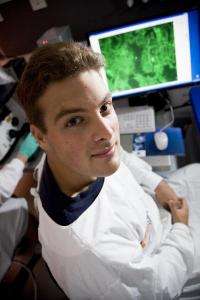Griffith's 3-D microscopy a research breakthrough

The understanding of diseases such as Parkinson's and Alzheimer's is set to take a step forward following groundbreaking technology at which will enable cell analysis using automated 3D microscopy.
An initiative between the Griffith's School of Information Communication Technology and the Eskitis Institute for Cellular and Molecular Biology, the technology will allow the automated identification, separation and analysis of cells as complex as nerve cells in the brain.
"Scientists and clinicians will be able to superimpose multiple data sets in three dimensions using automated techniques and then conduct detailed analysis of the data in a far improved way from the two dimensional microscopy that is currently available," said Dr Adrian Meedeniya, manager of Griffith's Imaging and Image Analysis Facility.
Microscopy and image acquisition technology has undergone a recent revolution, with modern microscopes generating huge multi-dimensional data sets that can easily fill an entire hard drive. Manually analysing these data-sets is incredibly time consuming and prone to human error and bias.
"One of the main motivations for establishing this collaboration with the School of ICT was to create the technology to efficiently deal with these huge data sets," Dr Meedeniya said.
"We will be able to use this technology to rapidly increase our understanding of the way neuro-degenerative disorders affect nerve cell function in the brain."
Underpinned by neural network algorithms (artificial intelligence), the cutting-edge technology is expected to be widely used in disease research within a matter of a few years.
















